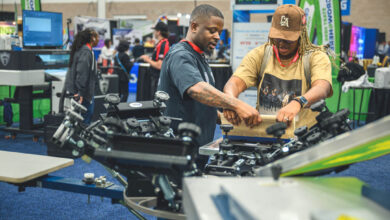
It’s a part of the screen printing press that is known by many names – platen, pallet, shirt board – to name a few of the more common descriptions. They’ve been manufactured with a variety of bases: wood, plywood, steel, aluminum, and various composites. Some of them are honeycombed, and/or covered with a variety of laminates or rubber, and they come in a variety of sizes to handle everything from Ts, children’s garments, sleeves, and more.
While much the attention in screen printing is paid to mesh, emulsion, and squeegees, often overlooked is the critical role of the platen and its leveling. Too often platens are treated as if they’re indestructible and level themselves.
The leveled platen must be strong enough to withstand print head or manual stroke pressure, which means no warping, bending, or bowing. Being flexible in this case is not an advantage. They must be sturdy and able to hold shape regardless of size. Whatever the surface, it must be smooth and even across its plane.
Earlier I had mentioned all the attention given squeegees and mesh. This was not to say these factors aren’t important but to recognize there are many elements that interact and being cognizant of how one tool or another can affect the outcome of the print is important. You need to use this knowledge to adjust the variables to make a print look exceptional. While much of the finesse in screen printing is generally attributed to experience, having a firm grounding in all the fundamentals is essential.
Leveling with you
First, discard all warped or bowed screens or platens. The money you will save in time and labor will more than pay for their replacement, and the absence of another headache will be welcomed. Often, when a printing a job that goes askew, printers blame a variety of elements. It’s the artwork. The screens weren’t burned correctly. The seps were done wrong. Seldom do we address the possibility of a leveling issue.
If the job is on deadline, one might crank up the squeegee pressure, which cranks the squeegee down. Once on-press, if you have registration/accuracy issues that occur every few shirts, it is often a leveling issue. This means the platen level to the screen needs to be adjusted. To produce quality prints, the platen and the screen must not only be centered, but they must also share the same plane, meaning they must be parallel. The more shirts you print, the more you should be checking this. Do it at least weekly to prevent the need for those last-minute adjustments.
What to look for
There are a variety of symptoms to look for. For unlevel platens, you may see a slight shift in the print to the left or right on the image. Years back, I recall reading an article about the dynamics of ink flow. It related that there were many factors to expect and to ensure the accuracy of colors in both spot and process colors, an even flow of ink is required. Critical to achieving this was the leveling of all platens and screens.
A simple way to check to see if your boards are level is to use your on-press flash unit as the standard to measure by. Rotate the boards around and note the distance between the bottom of the flash unit and each board with a ruler. Everything should be the same. If you find one or two that are out of standard, get those adjusted and solve your problem.



